Digital Poster
Stretch, Rotate & Twist: New RF Coil Designs II
ISMRM & ISMRT Annual Meeting & Exhibition • 03-08 June 2023 • Toronto, ON, Canada

| Computer # | |||
|---|---|---|---|
3895. |
141 |
Low field Breast and Chest Wall Imaging for MR guided Proton
Therapy
Neha Koonjoo1,2,
Torben P.P Hornung1,2,3,
Susu Yan3,4,
Matthew S Rosen1,2,5,
and Thomas R Bortfeld3,4
1Department of Radiology, A.A Martinos Center for Biomedical Imaging / MGH, Charlestown, MA, United States, 2Harvard Medical School, Boston, MA, United States, 3Department of Physics, ETH Zürich, Zürich, Switzerland, 4Department of Radiation Oncology, MGH, Boston, MA, United States, 5Department of Physics, Harvard University, Cambridge, MA, United States Keywords: Low-Field MRI, Breast, Hybrid & Novel System Technology The use of low field MRI guidance in proton therapy is a new area of research especially during treatment of breast cancer. In this study, we optimized and constructed five different breast/chest RF coils at low field as proof of concept for a future MR guided proton therapy system design. Different coil shapes and sizes were tested. Organs-at-Risk (OAR) and different anatomical regions were optimized for imaging. Using the five coils, phantom images were acquired at 6.5 mT and MR signal across slices were compared to the calculated optimized B1 field homogeneity. Human breast imaging was also carried out. |
|
3896.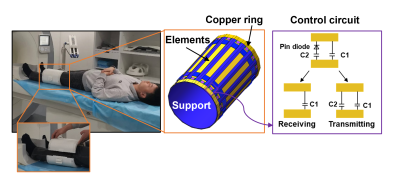 |
142 |
Knee MRI Using a Wireless and Passive Metasurface Coil
Yi Yi1,
Zhonghai Chi2,
Yakui Wang1,
Maopeng Wu2,
Lixue Wang1,
Deqing Jiang1,
Li He1,
Xihai Zhao3,
Yonggang Meng2,
Ji Zhou4,
Qian Zhao2,
and Zhuozhao Zheng1
1Department of Radiology, Beijing Tsinghua Changgung Hospital, School of Medicine, Tsinghua University, Beijing, China, 2State Key Laboratory of Tribology, Department of Mechanical Engineering, Tsinghua University, Beijing, China, 3Center for Biomedical Imaging Research, Department of Biomedical Engineering, School of Medicine, Tsinghua University, Beijing, China, 4State Key Laboratory of New Ceramics and Fine Processing, School of Materials Science and Engineering, Tsinghua University, Beijing, China Keywords: New Devices, Non-Array RF Coils, Antennas & Waveguides, Metasurface Metasurface is an effective solution to enhance SNR of MRI images. Here, we propose a wireless and passive metasurface coil and evaluate its performance in knee MRI. Phantom studies suggest improved image uniformity compared to the conventional phased-array radio-frequency coils. In vivo knee MRI of volunteers suggests higher image quality scores and better contrast of knee cartilage in metasurface groups. When used in conjunction with the spine coil, the metasurface coil provides a favorable SNR between that of the 4- and 12-channel phased-array coil. It is more convenient, cost-effective, and applicable to 1.5T MRI systems from different manufacturers. |
|
3897.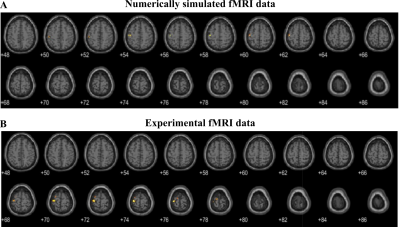 |
143 |
High permittivity ceramics for improving detection of fMRI
activation at 1.5T
Vladislav Koloskov1,
Mikhail Zubkov1,
Georgiy Solomakha1,
Viktor Puchnin1,
Anatoliy Levchuk1,2,
Alexander Efimtcev1,2,
Irina Melchakova1,
and Alena Shchelokova1
1School of Physics and Engineering, ITMO University, St. Petersburg, Russian Federation, 2Department of Radiology, Federal Almazov North-West Medical Research Center, St. Petersburg, Russian Federation Keywords: Hybrid & Novel Systems Technology, Hybrid & Novel Systems Technology, high permittivity materials, SNR enhancement We show that high permittivity materials (HPMs) can improve functional magnetic resonance imaging (fMRI) at 1.5T, increasing the receive sensitivity of a commercial multi-channel head coil. Both numerical simulations and experiment showed ~25% improvement in the signal-to-noise ratio (SNR) of a commercial head coil in the areas of interest when HPM blocks were placed in proximity. This led to an increase in the detected motor cortex fMRI activation volume by an average of 56%, thus resulting in more accurate functional imaging at 1.5T. |
|
3898.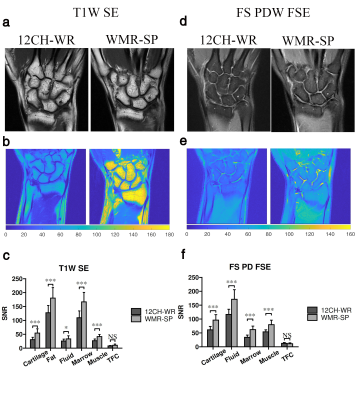 |
144 |
Improving signal-to-noise ratio and contrast in Wrist Magnetic
Resonance Imaging at 1.5T with Wireless Metasurface Resonantor
Yakui Wang1,
Zhonghai Chi2,
Yi Yi1,
Maopeng Wu2,
Lixue Wang1,
Deqing Jiang1,
Li He1,
Xihai Zhao3,
Yonggang Meng2,
Ji Zhou4,
Qian Zhao2,
and Zhuozhao Zheng1
1Department of Radiology, Beijing Tsinghua Changgung Hospital, School of Medicine, Tsinghua University, Beijing, China, 2State Key Laboratory of Tribology, Department of Mechanical Engineering, Tsinghua University, Beijing, China, 3Center for Biomedical Imaging Research, Department of Biomedical Engineering,School of Medicine, Tsinghua University, Beijing, China, 4State Key Laboratory of New Ceramics and Fine Processing, School of Materials Science and Engineering, Tsinghua University, Beijing, China Keywords: Non-Array RF Coils, Antennas & Waveguides, Joints, Metasurface We designed a wireless metasurface resonator(WMR) for wrist magnetic resonance imaging(MRI) at 1.5T and tested the imaging effect. Phantoms and 14 wrist jionts(7 healthy volunteers) were examed with T1W SE and fat-suppressed PDW FSE sequences at a 1.5T MRI system. Commercial 12-channel wrist array coil(12CH-WR) and WMR(coupling with integrated spine coil) were used to receive MR signal respectively. We found that WMR could improve the image SNR by 1.5~2 times, and significantly improve the image contrast compared with the traditional 12CH-WR. |
|
3899.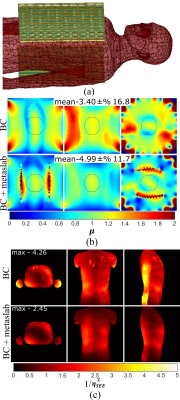 |
145 |
The Metaslab: A combined Metamaterial and Metasurface for
Improved Transmit Performance and Use as a Receive Array.
Lauren Smart1,
Adam Mitchell Maunder2,
Ashwin K. Iyer1,
and Nicola De Zanche2
1Electrical and Computer Engineering, University of Alberta, Edmonton, AB, Canada, 2Oncology, Medical Physics, University of Alberta, Edmonton, AB, Canada Keywords: RF Arrays & Systems, Body, metamaterial Abdominal and thoracic imaging at 3T suffers from inhomogeneous transmit fields and hot-spots in specific absorption rate (SAR) that limit image quality and imaging efficiency, respectively. We combine a lightweight metamaterial and metasurface (the ‘metaslab’) to enhance transmit efficiency and homogeneity, as well as to reduce SAR. The metaslab is further able to operate as a receive array with four distinct sensitivity patterns and sensitivity comparable to that of a conventional 4-element loop receive array. The metaslab is much lighter than comparable dielectric pads and achieves all these benefits in a similar package as a conventional coil array. |
|
3900. |
146 |
High impedance quadrature receivers array for magnetic resonance
skin imaging at 7T
Komlan Payne1,
Aditya A. Bhosale1,
Yunkun Zhao1,
and Xiaoliang Zhang1
1Department of Biomedical Engineering, University at Buffalo, Buffalo, NY, United States Keywords: Hybrid & Novel Systems Technology, RF Arrays & Systems The study of skin diseases is by far among the difficult research in biomedical field. Nowadays, many techniques are available to perform skin examination. Magnetic Resonance Imaging (MRI), a non-invasive technique can provide detailed image of the skin. For such procedure, a whole-body coil can be used as the transmitter while receivers array coils are placed in close proximity of the region of interest. In this abstract we design an array of high impedance quadrature detectors with good decoupling performance for skin image at 7T. |
|
3901.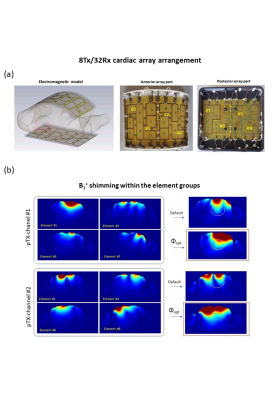 |
147 |
Transceiver 8Tx/32Rx array with L-shaped loop elements for
accelerated cardiac MRI at 7T: initial optimization and
experimental testing.
Maxim Terekhov1,
Ibrahim A. Elabyad1,
David Lohr1,
Anna Frey2,
Florian Schnitter2,
and Laura M. Schreiber1
1Chair of Cellular and Molecular Imaging,Comprehensive Heart Failure Center, University Hospital Würzburg, Wuerzburg, Germany, 2Department of Internal Medicine I, Cardiology, University Hospital Würzburg, Wuerzburg, Germany Keywords: RF Arrays & Systems, Parallel Transmit & Multiband, cardiovascular The concept of the L-shaped loop elements architecture with the antisymmetric arrangement was applied to develop a 8Tx/32Rx transceiver array for cardiac MRI at 7T. This work aimed to check B1+ shimming and parallel imaging capabilities of the array and to perform the initial testing in human thorax phantom and pig cadaver. Both phase-only and pTX optimization modes demonstrated the possibility for efficient shaping of B1+ with an optimized spatial homogeneity. Despite the sub-optimal geometry of the pig thorax, the array demonstrated a good B1+ coverage of the heart region with no apparent destructive interferences. |
|
3902.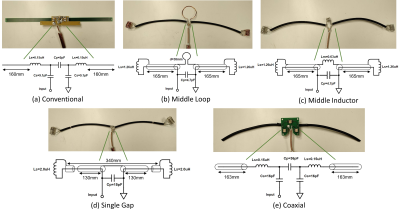 |
148 |
Towards Dense Flexible Transceive Coil Array: Comparison Study
of Coaxial Dipoles for 7T Human Torso MRI.
Jules Vliem1,2,
Raphael Tomi-Tricot1,3,4,
Irena Zivkovic2,
and Özlem Ipek1,3
1Biomedical Engineering, Kings's College London, London, United Kingdom, 2Electrical Engineering, Technical University of Eindhoven, Eindhoven, Netherlands, 3London Collaborative Ultra high field System (LoCUS), King's College London, London, United Kingdom, 4MR Research Collaborations, Siemens Healthineers, Frimley, United Kingdom Keywords: RF Arrays & Systems, High-Field MRI In this work, we explored properties of various coaxial dipole designs and compared them with the conventional dipole. Dipoles were fabricated of RG58 coaxial cable and the total length was 34cm. S-parameters and flip angle maps of individual elements and array configurations were measured on a torso phantom. Comparison of flip angle maps shows very similar performances of all examined dipoles with the coaxial dipole being slightly advantageous. When placed in densely populated array configuration, coaxial dipoles were sufficiently decoupled and produced expected B1+ maps. Coaxial dipole shows promising performances to be used in a densely populated flexible torso array. |
|
3903.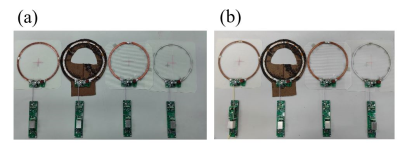 |
149 |
Performance comparisons of different single-channel coils using
different materials
Chunhu Song1,2,
Qiaoyan Chen1,2,
Shao Che1,2,3,
Haining Wang3,
Xiaoliang Zhang4,
and Ye Li1,2
1Paul C. Lauterbur Imaging Research Center, Shenzhen Institutes of Advanced Technology, Chinese Academy of Sciences, Shenzhen, China, 2Key Laboratory for Magnetic Resonance and Multimodality Imaging of Guangdong Province, Shenzhen, China, 3Shanghai United Imaging Healthcare, Shanghai, China, 4Department of Biomedical Engineering, State University of New York at Buffalo, New York, NY, United States Keywords: RF Arrays & Systems, RF Arrays & Systems The ultra-flexible RF coil can fit the image subjects well and thus improve signal-to-noise ratio (SNR). In this study, four types of single-channel receiver coils using different materials with the same size were constructed. Phantom studies were performed on a 3T MRI system. As a result, the liquid metal coil can achieve a most similar performance as the conventional copper coil, while the liquid metal coil is more flexible. This demonstrates that the liquid metal coil has a good application potential in imaging curved anatomical structures. |
|
3904.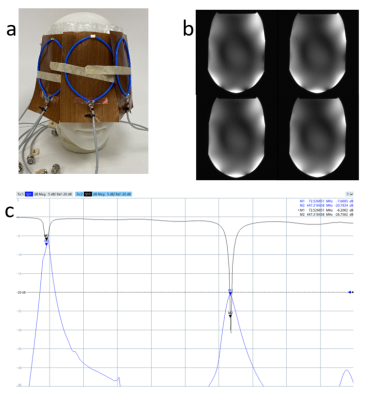 |
150 |
A Wrap-on Decoupled Coaxial Transmission Line (CTL) Transceive
Array for Head MR Imaging at 10.5T
Xiaoliang Zhang1,
Lance DelaBarre2,
Komlan Payne1,
Matt Waks2,
Gregor Adriany2,
and Kamil Ugurbil2
1Biomedical Engineering, State University of New York at Buffalo, Buffalo, NY, United States, 2Radiology, University of Minnesota, Minneapolis, MN, United States Keywords: RF Arrays & Systems, RF Arrays & Systems In this work, a wrap-on 447MHz transceiver array using the 2nd mode of coaxial transmission line resonator is designed, constructed and tested for human head imaging at the ultrahigh field of 10.5T. Results demonstrate the unique decoupling performance among the resonant elements achievable even for non-overlapped array layouts. The 10.5T images of a human head phantom acquired from the proposed array along with numerical simulations are shown. |
|
3905.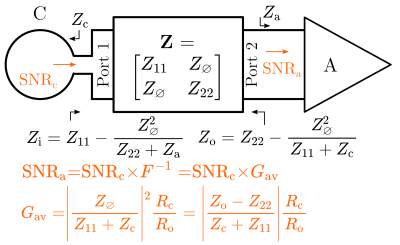 |
151 |
Estimating noise figure of matching networks for
low-input-impedance preamplifiers
Wenjun Wang1,
Juan Diego Sánchez Heredia2,
Vitaliy Zhurbenko1,
and Jan Henrik Ardenkjær Larsen2
1National Space Institute, Technical University of Denmark, Kongens Lyngby, Denmark, 2Department of Health Technology, Technical University of Denmark, Kongens Lyngby, Denmark Keywords: RF Arrays & Systems, RF Arrays & Systems, matching The noise figure of a matching network between a receive coil and a preamplifier with low input impedance can be estimated using relationship \(F\approx1+R_{11}/R_\mathrm{c}\). It is demonstrated how to use this relationship to choose optimal matching-decoupling network topology in terms of signal-to-noise ratio (SNR). The formula serves as an efficient tool to estimate noise figure of matching networks and is useful in low-field and high-coil-Q applications, where the noise of the matching network becomes comparable to coil noise. |
|
3906.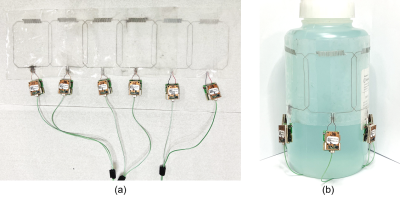 |
152 |
Multi-channel, Stretchable, Self-Tuning Coil Array Based on
Liquid Metal Technology
Elizaveta Motovilova1,
Terry Ching2,
Jana Vincent3,
Ek Tsoon Tan4,
Victor Taracila3,
Michinao Hashimoto2,
Fraser Robb3,
Darryl Sneag4,
and Simone Angela Winkler1
1Departmetn of Radiology, Weill Cornell Medicine, New York, NY, United States, 2Engineering Product Development Pillar, Singapore University of Technology and Design, Singapore, Singapore, 3GE Healthcare, Aurora, OH, United States, 4Department of Radiology and Imaging, Hospital for Special Surgery, New York, NY, United States Keywords: RF Arrays & Systems, RF Arrays & Systems, Liquid metal, Stretchable RF coils Stretchable receive coils can provide conformal fitting, improved SNR, and dynamic imaging capabilities. However, conductor stretching alters the resonance frequency, reducing potential SNR advantages. Previously, we proposed and demonstrated in a single element prototype a smart self-tuning coil design which allows to maintain the desired Larmor frequency with stretching. This work investigates the applicability of self-tuning techniques in a multi-channel stretchable coil array and demonstrates its performance in silico and in vitro. Simulation results show stable resonance frequency (<1%) and sensitivity (±5%) for varied load/stretching conditions. In vitro imaging demonstrates consistent performance of individual coil elements and the array (SNR=146). |
|
3907. |
153 |
Quantitative evaluation of two-dimensional flexible metasurfaces
at 3.0 T
Karthik Lakshmanan1,2,
Alena Schelokova3,
Stanislav Glybovski3,
Mary Bruno1,
and Christopher Collins1,2
1Bernard and Irene Schwartz Center for Biomedical Imaging, Department of Radiology, NYU Grossman School of Medicine, New york, NY, United States, 2Center for Advanced Imaging Innovation and Research (CAI2R), Department of Radiology, NYU Grossman School of Medicine, New york, NY, United States, 3ITMO University, St. Petersburg, Russian Federation Keywords: Non-Array RF Coils, Antennas & Waveguides, RF Arrays & Systems Quantitative evaluation of transmit efficiency and receive-specific SNR were performed for two different metasurfaces in a body-sized phantom for cases with 1) excitation and reception using the system body coil and 2) excitation with the system body coil and reception with a commercial 12-element array. Similar evaluations were performed for one of the metasurfaces in vivo with the receive array present, and for comparisons all measurements were also made with no metasurface present. Both metasurfaces were seen to significantly improve transmit efficiency in all cases, and to improve SNR when the body coil was used for reception, with effects being strong near the metasurface and extending toward the center of the phantom. The metasurfaces had minimal effects on receive SNR of the commercial Rx array. |
|
3908.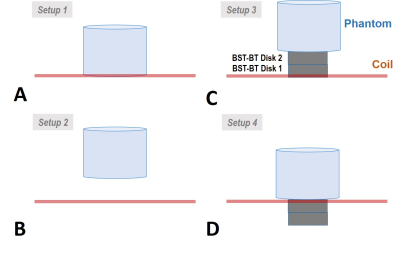 |
154 |
Investigating the effect of ultra-High Dielectric Constant
(uHDC) ceramic disk placement on RF coil performance for optimal
MRI applications
Xin Li1,
Hannes M. Wiesner1,
Xiao-Hong Zhu1,
and Wei Chen1
1Department of Radiology, University of Minnesota, Minneapolis, MN, United States Keywords: Non-Array RF Coils, Antennas & Waveguides, RF Arrays & Systems It has been demonstrated that integrating ultra-High Dielectric Constant (uHDC) materials with a RF coil can achieve large improvement in RF magnetic field (B1) and imaging sensitivity. A typical configuration inserts the uHDC materials between the imaging object and the RF coil, resulting in a weak B1 from the coil due to the distance from the object. In this study, we explored different configuration options and found that the best arrangement was to place the uHDC materials outside the coil, leaving no gap between the RF coil and the object, for optimal imaging applications. |
|
3909.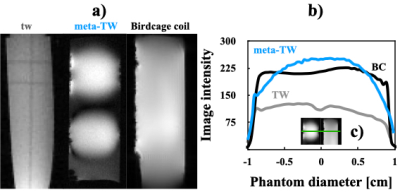 |
155 |
Remote detection MRI using a flexible non-selective metamaterial
at 7 T
Sergio Solis-Najera1,
Jelena Lazovic2,
Fabian Vazquez1,
and Alfredo Odon Rodriguez3
1Departamento de Fisica, UNAM, Mexico City, Mexico, 2Department of Physical Intelligence, Max Planck Institute for Intelligent Systems, Stuttgart, Germany, 3Electrical Engineering, UAM Iztapalapa, Mexico City, Mexico Keywords: Non-Array RF Coils, Antennas & Waveguides, RF Arrays & Systems, travelling-wave We propose a method to remotely acquire MR images at 7 T with a preclinical imager using a bio-inspired surface coil, a parallel-plate waveguide and a non-selective metamaterial. Phantom images were acquired with and without a flexible metasurface inserted in cylindrical phantom filled with saline solution and a birdcage coil. Uniformity profiles were computed for all cases showing that the birdcage coil and metasurface profiles have a very good correspondance. An improvement was observed for the images obtained with the metasurface. This approach offers a convenient alternative to obtained high quality images. |
|
3910.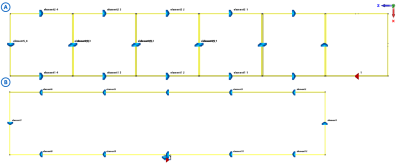 |
156 |
A coupled planar RF array for ultrahigh field MR imaging
Yunkun Zhao1,
Komlan Payne1,
Leslie YIng1,
and Xiaoliang Zhang1
1Biomedical Engineering, State University of New York at Buffalo, Buffalo, NY, United States Keywords: New Devices, Spinal Cord This study proposes a coupled planar radio frequency (RF) array for spine imaging at 7T. Multiple identical loop coils are closely placed to achieve strong EM coupling in order to form a multimodal resonator. This coupled resonator can design large high-frequency RF coils for ultrahigh field imaging applications in humans. |
|
3911. |
157 |
Considerations for Accurate Active Detuning Measurements in
Densely Parallel Array Coils
Manisha Shrestha1,
Mirsad Mahmutovic1,
Sam-Luca JD Hansen1,
Jason P Stockmann2,
and Boris Keil1
1Institute of Medical Physics and Radiation Protection, TH Mittelhessen University of Applied Sciences, Giessen, Germany, 2A.A. Martinos Center for Biomedical Imaging, Massachusetts General Hospital, Harvard Medical School, Boston, MA, United States Keywords: RF Arrays & Systems, High-Field MRI, detuning Active detuning of receive array coil during transmit prevents large currents being induced in the coil which could damage sensitive electronic components and create SAR hotspots. The standard method of adjusting active detuning using a double probe shows an offset in the resonant frequency set at bench when tested in the presence of a scanner. Setting a high impedance at the input of loop using S11 measurement exactly at Larmor frequency has proven to be a better method to detune loops actively.
|
|
3912.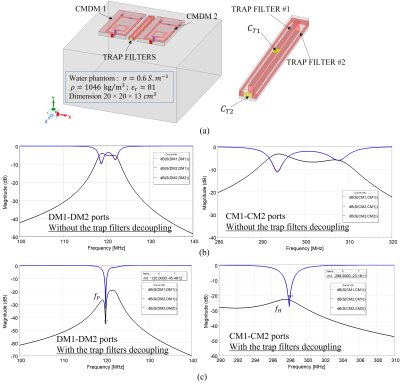 |
158 |
Design of a Highly Decoupled Compact Dual-tuned Transceiver RF
Coil Arrays for 1H MRI and 31P MRSI at 7T
KOMLAN PAYNE1,
Aditya Ashok Bhosale1,
Leslie Lei Ying1,
and Xiaoliang Zhang1
1Department of Biomedical Engineering, University at Buffalo, Buffalo, NY, United States Keywords: Parallel Imaging, Multimodal, Dual nuclear In this work, we developed a decoupled multichannel double-tuned RF coil array for 1H/31P MR imaging and spectroscopy at the ultrahigh field of 7T. One of the difficulties in designing such high-frequency double-tuned coil arrays is to electromagnetically decouple the two frequency channels simultaneously. To address this issue, we designed a double-crossed magnetic wall (or ICE) decoupling which can independently and simultaneously decouple the 1H channels and 31P channels. With the improved performance, this developed 1H/31P transceiver array is expected to offer improved detection quality and imaging speed in 1H/31P metabolic imaging applications at 7T. |
|
3913.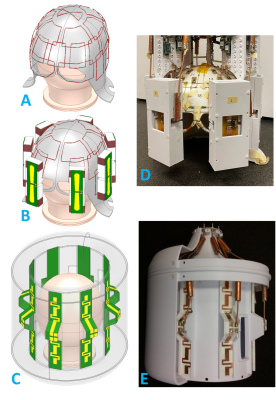 |
159 |
Boosting Central Head SNR at 10.5T: 32-channel Hybrid RF Coil
Comprised of 25 Rx-only Loops and 7 TxRx NODES Dipoles
Alireza Sadeghi-Tarakameh1,
Matt Waks1,
Andrea Grant1,
Jeromy Thotland1,
Russell L Lagore1,
Lance DelaBarre1,
Edward Auerbach1,
Pierre‐Francois Van de Moortele1,
Gregor Adriany1,
Kamil Ugurbil1,
and Yigitcan Eryaman1
1Center for Magnetic Resonance Research (CMRR), University of Minnesota, Minneapolis, MN, United States Keywords: RF Arrays & Systems, High-Field MRI Higher signal-to-noise ratio (SNR) is the primary maxim for increasing the magnetic field strength of MRI scanners. However, RF coils comprised of loops do not capture the highest achievable SNR that is theoretically available at ultrahigh field (defined as ≥7T) MRI. In this study, we investigate the hypothesis of increasing central head SNR at 10.5T by combining loop and dipole receiver elements. For this purpose, we manufactured a 32-channel hybrid RF coil comprised of 25 receive-only loops and 7 transceiver NODES dipoles. This 32ch hybrid coil achieved ~80% higher central SNR compared to a 32ch loop array. |
|
The International Society for Magnetic Resonance in Medicine is accredited by the Accreditation Council for Continuing Medical Education to provide continuing medical education for physicians.